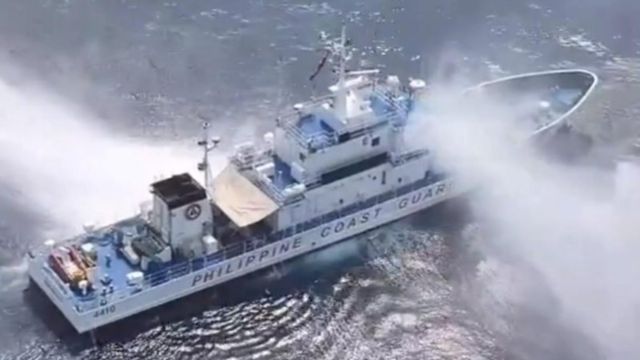Chinese coast guard ships have reportedly used water cannons to disperse Philippine vessels in a disputed area of the South China Sea. The incident occurred near the Scarborough Shoal, marking another encounter between the two countries in these waters.
According to a statement by Commodore Jay Tarriela, the spokesman for the Philippine Coast Guard, the incident took place on Monday morning. Two Philippine maritime patrol vessels came across four Chinese coast guard and six Chinese maritime militia vessels near the Scarborough Shoal.
The Philippines refers to the shoal as Bajo de Masinloc, a triangular chain of reefs and rocks located approximately 120 nautical miles west of the Philippine coast. China has blockaded and laid claim to this area since a standoff in 2012.
According to Tarriela, a Chinese ship targeted the Philippine ships with its water cannon, hitting one vessel when they were approximately 12 nautical miles away from the shoal. The other Philippine ship experienced damage to its railing and canopy after being struck by water cannons from two Chinese ships at a distance of around 1,000 yards from the shoal.
Tarriela wrote that the damage on the vessels serves as clear proof of the aggressive water pressure exerted by the China Coast Guard during their harassment of the Philippine vessels.
According to him, the entire entrance of the shoal is now covered by a 380-meter (1,250-foot) floating barrier installed by China. This barrier effectively limits access to the area.
In 2019, the Philippines took action to remove a floating Chinese barrier at Scarborough Shoal. This barrier had been obstructing Filipino vessels from accessing the traditional fishing ground.
On Tuesday, the Chinese coast guard took action by expelling two Philippine vessels that were deemed to have “illegally intruded” in the waters off of Huangyan Island, which China refers to as the shoal.
The Scarborough Shoal is located within the exclusive economic zone (EEZ) of the Philippines. According to the United Nations Convention on the Law of the Sea, a country’s EEZ extends 200 nautical miles from its coast.
China, on the other hand, asserts its ownership of nearly the entire South China Sea, a claim that was dismissed by an international tribunal in The Hague back in 2016. In the past few months, there have been multiple maritime incidents between the two sides, with a notable collision caused by Chinese vessels at the Second Thomas Shoal in March.
As the United States and the Philippines conduct a large-scale joint military exercise in the South China Sea, a recent incident has occurred. This exercise involves live-fire missile launches and a boat-sinking drill.
Beijing has expressed its anger over the annual Balikatan exercise, arguing that it will only escalate tensions in the region.
Philippine President Ferdinand Marcos Jr. has been actively seeking closer relations with Washington since assuming power in 2022, as his predecessor Rodrigo Duterte had strained the alliance in an attempt to enhance ties with Beijing.
Earlier this month, President Joe Biden hosted Marcos Jr. and Japanese Prime Minister Fumio Kishida for the first-ever trilateral summit between the United States, the Philippines, and Japan. During the summit, President Biden affirmed Washington’s unwavering commitment to the Philippines in the face of China’s growing assertiveness in the South China Sea.



